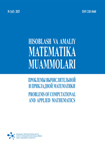Numerical modeling of turbulent transport of impurities in a spatially inhomogeneous atmospheric environment
DOI:
https://doi.org/10.71310/pcam.1_63.2025.06Keywords:
turbulent diffusion, Navier-Stokes equations, ???? − ???? turbulence model, pollutant dispersion, urban airflows, numerical modeling, finite difference method, environmental safetyAbstract
This study presents a mathematical model for turbulent pollutant dispersion in urban airflows based on the Navier-Stokes equations and the ????−???? turbulence model. The model incorporates meteorological parameters, emission sources, and urban structures. A finite difference numerical method is used to solve the equations. Computational experiments demonstrate pollutant concentration patterns in urban environments. The results indicate that wind turbulence and building geometry significantly influence dispersion. The model can aid in urban planning and environmental safety. Simulation findings highlight the importance of wind circulation in reducing pollution. The study provides practical recommendations for optimizing urban design.
References
Batchelor G.K. 1967. An Introduction to Fluid Dynamics. // Springer. https://link.springer.com/book/10.1007/978-1-4612-4682-3
Kolmogorov A.N. 1941. The Local Structure of Turbulence in Incompressible Viscous Fluid for Very Large Reynolds Numbers. Springer. https://link.springer.com/article/10.1007/BF01341274
Smagorinsky J. 1963. General Circulation Experiments with the Primitive Equations. // Springer. https://doi.org/10.1175/1520-0469(1963)020<0223:GCEWTP>2.0.CO;2
Launder B.E., Spalding D.B. 1974. The Numerical Computation of Turbulent Flows. Springer. https://doi.org/10.1016/0021-9991(74)90029-2
Spalart P.R., Allmaras S.R. 1992. A One-Equation Turbulence Model for Aerodynamic Flows. La Recherche Aérospatiale. https://arc.aiaa.org/doi/10.2514/3.48238
Wilcox D.C. 2006. Turbulence Modeling for CFD. DCW Industries. https://www.dcwindustries.com/turbulence-modeling-for-cfd
Patankar S.V. 1980. Numerical Heat Transfer and Fluid Flow. Hemisphere Publishing. // https://www.taylorfrancis.com/books/mono/10.1201/9781482234213/numericalheat-transfer-fluid-flow-suhas-patankar
Togrul I.T., Pehlivan D. 2004. Modelling of thin layer drying kinetics of some fruits under open-air sun drying process // J. Food Eng. – Vol. 65, – 3. – P. 413–425.
Versteeg H.K., Malalasekera W. 1995. An Introduction to Computational Fluid Dynamics: The Finite Volume Method. Pearson Education. // https://www.pearson.com/store/p/introduction-to-computational-fluid-dynamics-thefinite-volume-method/P100000150280
Menter F.R. 1994. Two-Equation Eddy-Viscosity Turbulence Models for Engineering Applications. // AIAA Journal. https://doi.org/10.2514/3.12149
Pope S.B. 2000. Turbulent Flows. Cambridge University Press.
Davidson P.A. 2004. Turbulence: An Introduction for Scientists and Engineers. // Springer. https://doi.org/10.1093/acprof:oso/9780198722595.001.0001
Moukalled F., Mangani L., Darwish M. 2016. The Finite Volume Method in Computational Fluid Dynamics. // Springer. https://link.springer.com/book/10.1007/978-3-319-16874-6
Schlichting H., Gersten K. 2016. Boundary-Layer Theory. // Springer. https://link.springer.com/book/10.1007/978-3-662-52919-5
Sharipov D., Muradov F., Akhmedov D. 2019. Numerical Modeling Method for Short-Term Air Quality Forecast in Industrial Regions. // Applied Mathematics E-Notes. https://doi.org/10.1051/matecconf/201818203002
Duraisamy K., Iaccarino G., Xiao H. 2019. Turbulence Modeling in the Age of Data. // Annual Review of Fluid Mechanics. https://doi.org/10.1146/annurev-fluid-010518-040547
Bae H.J., Lozano-Durán A., Moin P. 2018. Turbulence Spectra in Wall-Bounded Flows: Scaling Laws and Universality. // Journal of Fluid Mechanics. https://doi.org/10.1017/jfm.2018.499
Agresti A., Veraar M. 2024. Stochastic Navier–Stokes Equations for Turbulent Flows in Critical Spaces. // Communications in Mathematical Physics. https://link.springer.com/article/10.1007/s00220-023-04867-7
Brun C., Bertoglio J.P. 2008. Subgrid-Scale Models for Large-Eddy Simulations Based on Energy Spectrum Considerations. // Journal of Fluid Mechanics. https://doi.org/10.1017/S0022112008004396
Durbin P.A. 2021. Modern Developments in Turbulence Modeling. Annual Review of Fluid Mechanics. // https://doi.org/10.1146/annurev-fluid-011020-073553
Taira K., et al 2017. Modal Analysis of Fluid Flows. // AIAA Journal. https://doi.org/10.2514/1.J056060
Ishihara T., Gotoh T., Kaneda Y. 2009. Study of High-Reynolds Number Isotropic Turbulence. Annual Review of Fluid Mechanics. // https://doi.org/10.1146/annurev.fluid.010908.165203P. – P. 575–584.





